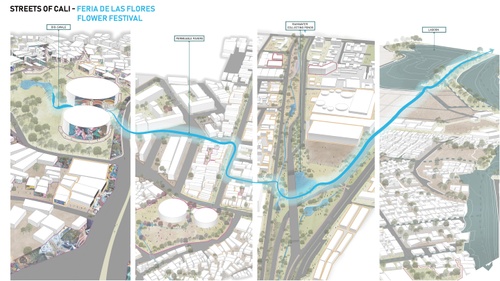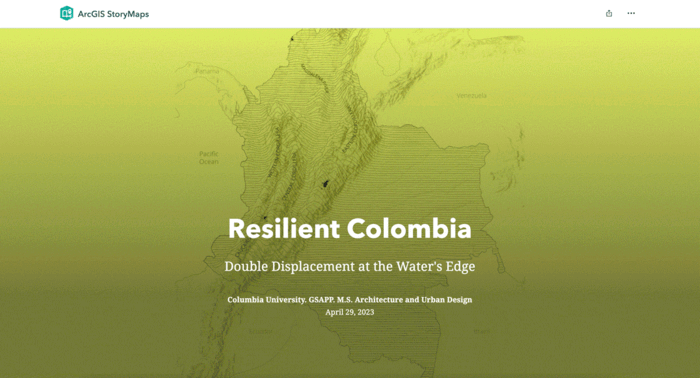Introduction
Urban Design
The Urban Design program engages the complex processes of global urbanization amid the emerging stress of the climate crisis. Ways of living in cities and landscapes around the world are increasingly untenable, and now require new forms of research and attention. What is the agency of design in these rapidly shifting conditions? The program frames the city not as a fixed, delineated territory but instead as a gradient of landscapes supported by networks of energy, resources, culture, mobility, and capital. It addresses near and long term threats to local, regional, and global ecosystems, positioning design as both an inclusive, activist, tools-based project for specific sites and communities, and as a critical project examining urban form, process, and knowledge.
Studios
Spring 2023
Studio III
Water Urbanism Colombia
Water Urbanism Colombia
This studio explored watery landscapes and contested urban terrain in Colombia, with a special focus on climate justice in Cali, Cartagena, and Bogotá. As a studio we asked, how has risk been produced and experienced through spatial exclusion, urban planning, and design? How can we approach “resilience” critically and understand the confluence of social, political, and ecological factors? Rapid development in Cali is provoking investment in the levee system El Plan Jarillón which is intended to “protect” people; however, this adaptation project is also an engine of displacement. How does exclusion from the housing market create and formalize risk? In Cartagena, diminishing water quality and the crush of extractive tourism threatens its bays and creates a divided city of haves and have-nots. Bogotá’s rapid growth encroaches on the critical landscapes of the Cerros de Bogotá, the globally significant paramos ecosystem, and Río Bogotá. How does the right to housing intersect with broader ecological imperatives like ecocide, deforestation, and the collapse of biodiversity and clean water? Students and faculty worked together over the course of the semester to explore how urban designers can act as multipliers of change, integrators of expertise, visionary partners, allies, and advocates.

Network of Care and Water Visibility
Network of Care revives the Sabana de Bogota, a wetland that Muiscas once inhabited with a sense ...

Calles Para Cali
Cali is said to be the cultural capital of Colombia that accentuates each moment of ‘everyday lif...

Expansion of Fucha
Our project deploys a rezoning strategy to reclaim, revive, and revalue waterbodies in Sabana ...

Rio Tunjuelo - The Winding Middle
The meanders of the Tunjuelo River once worked to slow its flow and increase its holding capacity...

FOR THE BIRDS: STEWARDSHIP AND REPAIR IN JABOQUE WETLAND
Bogota is a hotspot of biodiversity and a popular destination for bird-watchers. Birds are not on...

Muisca Lowlands
Muisca Lowlands seeks to heal people’s relationships with water by reimagining ways of living wit...

Water Holding Across a Broad Geography
Considering fields as the seed of change to form a new flood-resistant infrastructure, we aim to ...

New circular economy for Cartagena
The communities settled in the South of Ciénaga de la Virgen are economically and environmenta...

River Culture in Cali
Our project River Culture In Cali proposes strategies to counter cycles of injustice and build co...

Citizens of the Forest
Bosque Calderón lies at the base of the Eastern Hills of Bogotá at the intersection of the Mounta...

Terrenos de Agua: Water at the First Frontier
The vibrant life unfolding on the foothills of Cali is deeply stigmatized and associated only ...
Fall 2022
Studio II
How can we disentangle urban design and architecture from property? How can we use this moment of environmental and institutional reckoning to disassemble the exploitative regimes of speculation and displacement that anchor the built environment? In other words, where do we go from here? This studio aims to identify temporal slippages and spatial practices that carve out moments of liberation from the limits of property. Studio participants will develop a collective intelligence, by gathering samples from various cultural and political geographies, to experiment with ways of seeing beyond the privatized enclosure in the metropolitan Atlanta region— the city and its sprawling suburbs. The aim is to design a region (with hopes of building a world) that is not tethered to individual land ownership, but instead, predicated on collective stewardship and care. This work will be done by recognizing, drawing, and modeling ordinary spatial practices that operate against the hegemony of real estate—systems that value people over property— in order to develop a dynamic catalog of spatio-temporal constructs. Through radical reinterpretations of historical and contemporary interventions where the everyday struggle begins to approach the surreal—or even, the sublime—we aim to liberate urban design from its historical commitment to borderization. We will celebrate undervalued spatial practices that actively dismantle the cartesian frame of racial capitalism, as a gathering of performances committed to imaging a different world, because the status-quo is untenable. Atlanta After Property reframes the discipline of urban design by reimagining the city of Atlanta in solidarity with contemporary movements of Black liberation, anti-coloniality, and mutuality; working against the ruthless policing, dispossession, and displacement of marginalized communities.

Wood Spectacle
We believe that in current society, property is a framework for social, economic, and political r...

Living Network
Property is the catalyst of a racialized system of perpetual displacement. It is a system that pr...

The Last Great Necessity
Death isn’t expensive, but the socio-economic regulations that are entangled around the rituals r...

De/Network
The regime of property upholds possession, exclusion and control as markers of value. It reinforc...

De-Marking
Atlanta and its communities have fallen victim to the city’s decision to prioritize cars, embeddi...

Abolitionist Future: Atlanta Towards Care
The justice system in the United States is widely dependent upon celebrating criminalization, cop...

Healthcare After Property
Within the bounds of one’s home, health is a value system. It is in the soup brewed with herbal g...

Rewilding Peachtree
The Downtown Peachtree district sits at the heart of Downtown Atlanta. The large-scale division a...

Greenbriar Palace
The suburban shopping mall is “property” built for the consumption and lifestyle of the American ...

Tracing Roots
Water holds the past and present. Deciphering it´s layers, it mirrors decisions and the way land ...

Making as Healing
After the Civil War, Black Southerners were no longer enslaved, but they were not yet free. The S...

Atlanta After Games
Olympic legacy includes the long-term benefits that the Olympic Games create for the host city, i...

City of the Forest
Property is a social, spatial tool enacted to fortify the regime’s continuum of power and control...
Summer 2022
Urban Design Studio I
The Summer Studio provides a framework for students to expand their design thinking using New York City as a laboratory. Three ambitions guide the studio research: to nurture a design process specific to existing urban environments, to critically consider site and program, and to interrogate the role of Urban Design in service to the public as a client. More broadly, students are introduced to a post-industrial, built-out American city through its past, current and future layers of neighborhoods, public spaces and infrastructures. This already complex landscape is now implicated in climate change—from sea level rise to extreme weather, from systems failure to environmental justice, and from technological improvements to “sustainable” living. This 21st century landscape also requires an array of emergent Urban Design tools for researching, mapping, investigating and hypothesizing the continuous process of urbanization.
Seminars
Spring 2023
Immeasurable Sites
What methods of spatial valuation undergird the disciplines of architecture and urban design? How are these systems of measurement entangled with discursive and material regimes of racialization, ecological degradation, and coloniality? This course considered sites and practices that travel beyond disciplinary rubrics of measurement. Participants examined tactics of opacity, occlusion, and abstraction, in the visual and conceptual arts; paying special attention to nonwestern concepts and sites that are illegible to the ethnographic gaze. Thinking and working against epistemologies of measurement, classification, and bordering, requires developing transdisciplinary knowledge of black studies, decoloniality, contemporary art, and cultural geography. Each week’s readings were split in half between practices of measurement that have been central to the discipline of architecture and extra-disciplinary concepts of immeasurability.
Portfolios




























